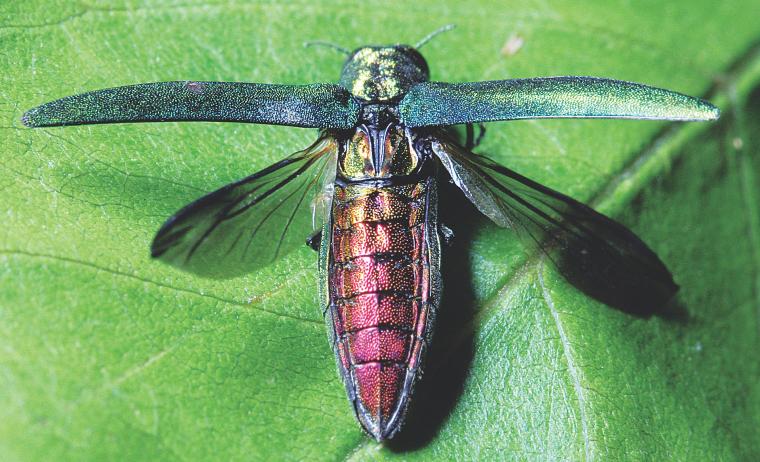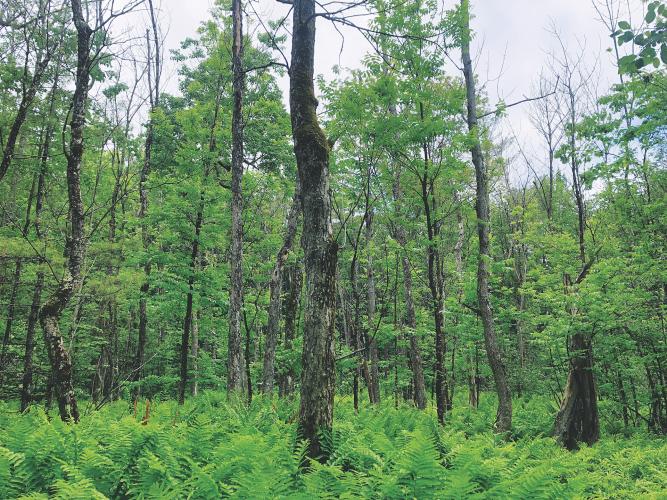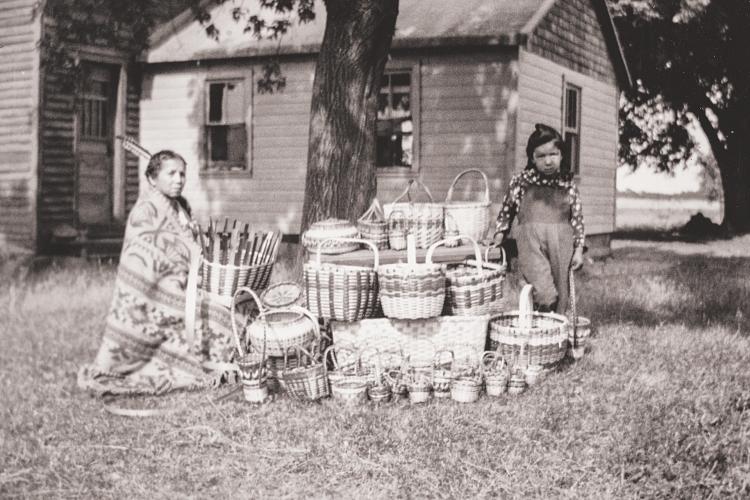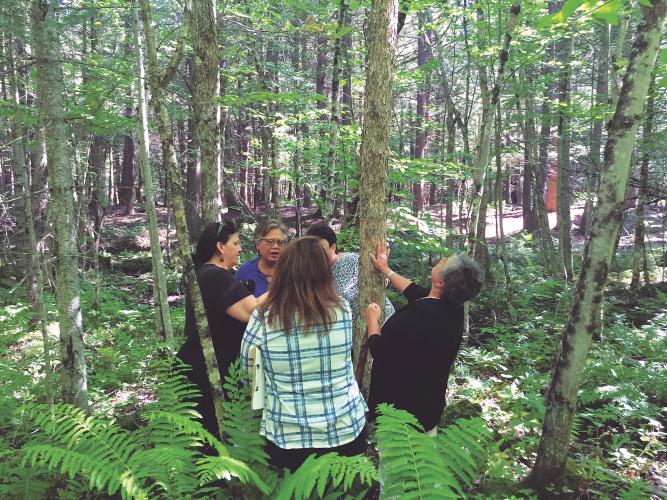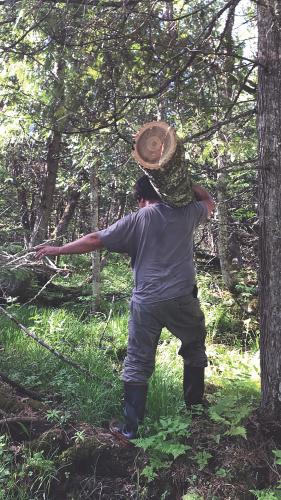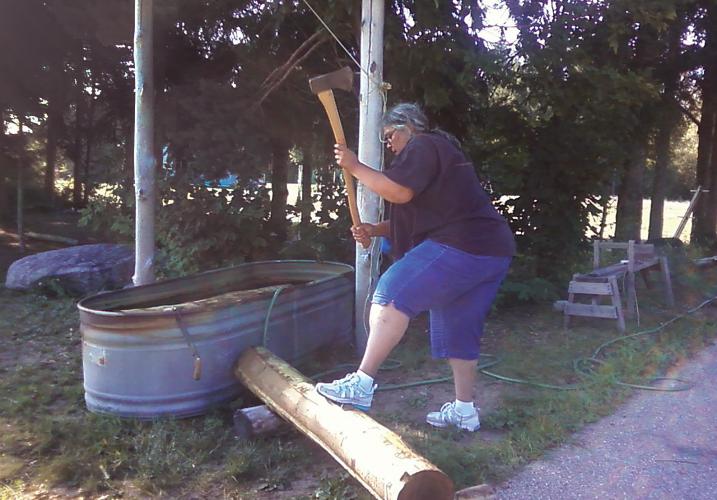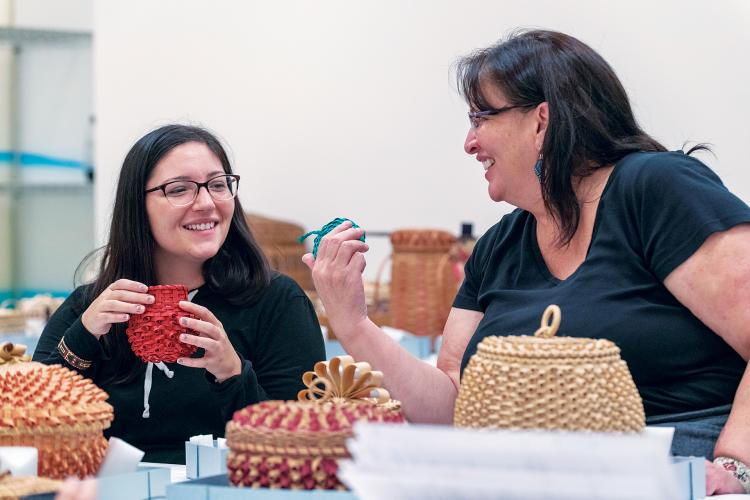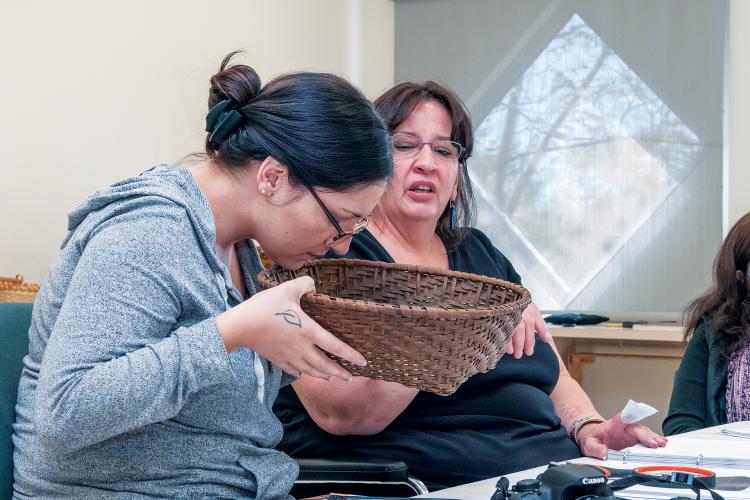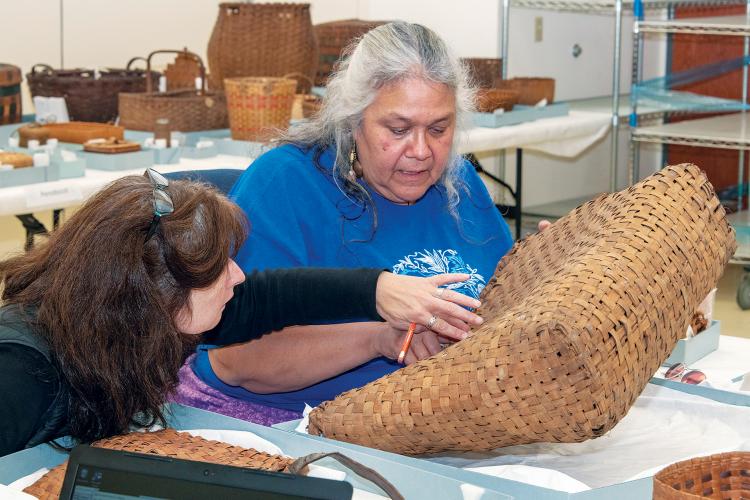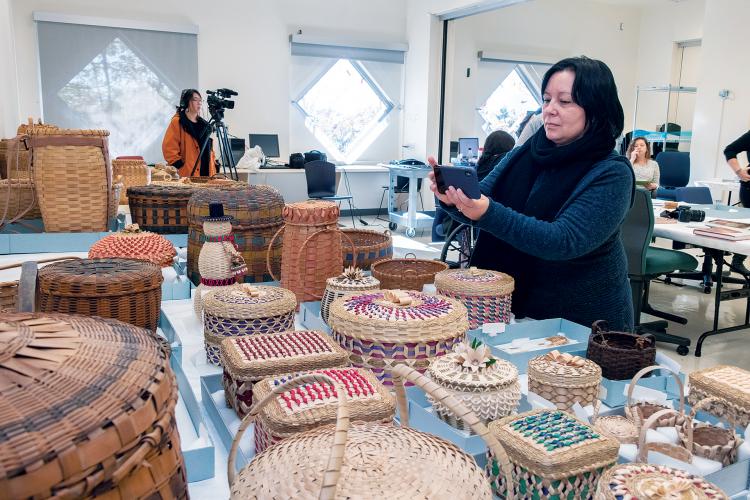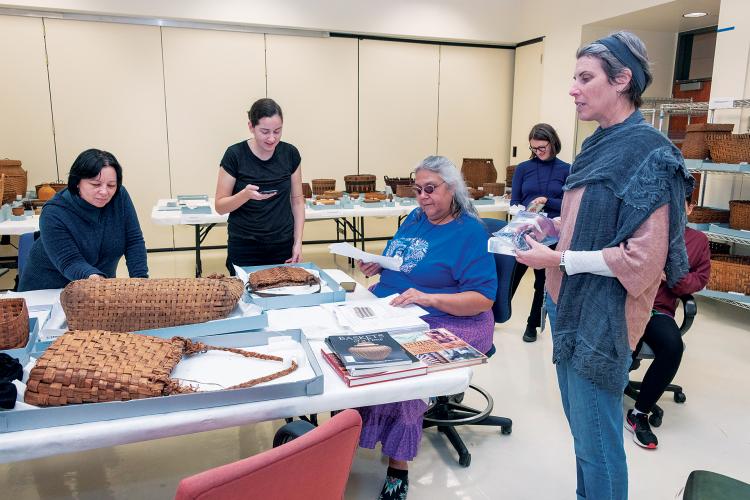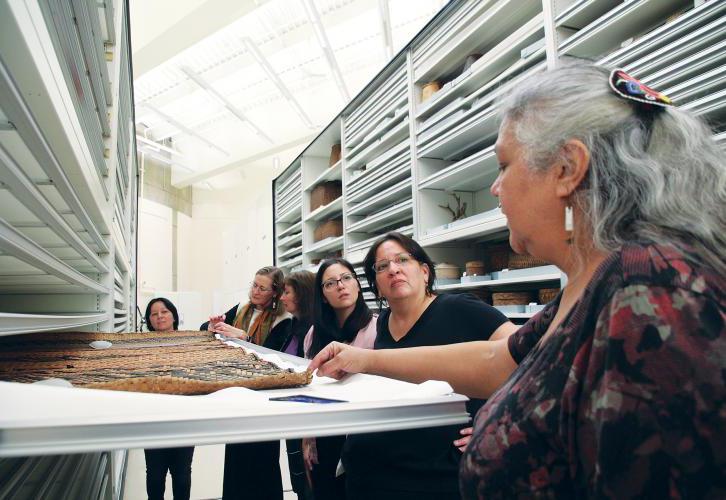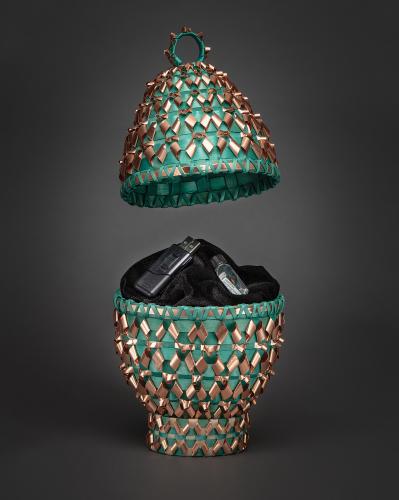In 2014, Renee Wasson Dillard was standing near her truck, getting ready to put on her rubber boots and walk into her “honey hole”—her favorite grove of black ash trees a few miles from her Anishinaabe community on the northwest coast of Michigan. A member of the Little Traverse Bay Bands of Odawa Indians, Dillard had been making her living as a basket maker for 18 years. She visited this swamp at least once a month to find at least one straight tree that could provide wood for her baskets. Then it happened: a glimmering emerald ash borer landed on her shoulder. She knew this invasive beetle had infested the forest and her precious ash trees would soon be gone. “I just sat there and cried,” she recalls. “It was devastating.”
Smaller than a penny, these deceptively beautiful bugs have killed millions of ash trees in North America during the past two decades—and they show no signs of stopping. Many American Indian and First Nation basket makers have relied upon black ash for its pliable, durable wood for centuries. Now this unique species is disappearing before their eyes. Yet they are not giving up without a fight. In addition to their on-the-ground efforts to protect remaining black ash, an innovative Smithsonian partnership is enabling a band of Native sister basket makers to study a rare collection of baskets that could help them keep their heritage alive.
Femmes Fatal
As have many other basket makers, Dillard first heard about the emerald ash borer from Ottawa/Pottawatomi basket maker Kelly Church. Growing up in southwestern Michigan during the 1970s, Church was in her thirties before she and her 12-year-old daughter, Cherish Parrish, decided to learn black ash basketry together from Church’s father and cousin. In 2003, she was demonstrating basket making at Michigan State University when Deborah McCullough, a forest entomologist from the institution, handed her a flier about a new invasive insect that was devastating ash trees. “My whole world changed,” says Church.
McCullough remembers receiving the call in June 2002 to go out to look at some sick ash trees near Detroit. When she pulled off a section of a tree’s bark, she was shocked: its inner bark was covered with extensive “galleries,” S-shaped tunnels dug by boring insect larvae. Trees can usually survive such damage from a few native boring insects, but this was massive. “They just had larval galleries all over them,” she says. “I had never seen that on ash trees. No native insects feed on them like that.”
Researchers sent beetles collected from dying trees to Oregon State University, London's Museum of Natural History and the Smithsonian, but experts could not match it to any known North American species, even in the Museum of Natural History’s 35 million insect collection. Eduardo Jendek at the Institute of Zoology at the Slovak Academy of Sciences finally identified the species as Agrilus planipennis. McCullough and her colleagues dubbed the metallic-colored beetle the “emerald ash borer,” or EAB.
The researchers suspect the invasive insect was transported to the United States on wooden crates, pallets or dunnage. Indigenous to China and South Korea, EAB does not kill healthy Asian ash species. However, it can colonize all of the 16 ash tree species in North America, and it is partial to black and green ash. The adult beetles that nibble on leaves aren’t really the problem. Females lay eggs on the bark. When the eggs hatch, the larvae burrow into and feed on the inner bark, leaving trails that disrupt the tree’s ability to transport water and nutrients.
Because the larvae’s damage is hidden beneath bark, landowners often don't realize their trees have been infested until signs such as dying branches become apparent—which could be up to five years later. Many people are also unaware of or have ignored U.S. Department of Agriculture (USDA) quarantines barring the transport of ash trees, logs or firewood from infested states. As a result, this near-invisible invader has spread quickly. The Emerald Ash Borer Information Network reports the insect is now found in 35 states and the Canadian provinces of Ontario, Quebec, New Brunswick, Nova Scotia and Manitoba.
Nothing Quite Like It
Black ash occupies a unique ecological and cultural niche. It can grow on well-drained stream edges and ridges but is also one of the few woody plants that thrive in wetlands and bogs. It supports a variety of plant-eating species, including Hercules and rhinoceros beetles, rare moths such as the Canadian sphinx and tadpoles, which feast on its fallen leaves. An average tree lives 35 to 100 years, but some can survive more than 200 years.
Native weavers in what is now the Great Lakes and Northeastern United States and eastern Canada have known for centuries that when it comes to a hard but flexible wood that can be coaxed, bent and twirled into a basket, nothing compares to black ash. Jennifer Neptune, a Penobscot basket maker from Maine’s Indian Island who has been creating intricate baskets for 30 years, agrees: “I’ve tried different trees. There’s nothing that can replace black ash.” It is even part of the Penobscot people’s creation story.
Adriana Greci Green is a curator of Indigenous Art of the Americas at The Fralin Museum of Art at the University of Virginia. She explains that the sturdy wood of black ash was first used to create utilitarian baskets to carry food or other heavy objects. By the mid-19th century, settlers began buying laundry and shopping baskets from Native women who would sell door-to-door. Later, resort tourism in some towns developed a market for “fancy” baskets, ones decorated with complex curls or colored with dyes made from berries or other natural materials. In her Michigan community, says Dillard, “If you ate well or had new shoes for your kids, it was because you made baskets.”
By early 20th century, more Native people were living in urban areas. While the Depression in the 1930s greatly reduced demand, many Native people still eked out a living with their weaving skills. But by the 1940s, other jobs, such as cleaning houses or factory work, paid more. Greci Green says, “getting the tree, hauling it out—young people didn’t want to do that backbreaking work.”
Another factor that impacted basket making was that beginning in the late 1800s and well into the 20th century, U.S. government officials forced American Indian children into boarding schools, where teachers forbade them to continue their cultural practices. “It’s an amazing story that anyone recalls making baskets,” Dillard says.
The Personality of an Ash
The process of making a black ash basket starts in the woods, usually a muddy swamp. While collecting a tree can be a family or a community affair, doing so is still no easy matter. “Any basket maker worth her salt has had her boots sucked off her feet,” says Dillard laughing.
In the forest, you have to be able to identify not only a black ash, but a “basket-quality” tree, one that is at least 25 years old, straight and not full of blemishing knots. Once a good candidate is found, the gatherer will cut a small wedge from the trunk to make sure it shows at least eight growth rings and that they are wide enough to be split apart. If the tree is not appropriate, the hole will be patched with mud and the gatherer will move on.
However, if a choice tree is found, it is thanked for what it is about to offer. Dillard says she asks the tree for its permission to be taken and then tells it, “They are going to love you. You are going to be in a new form.”
After the tree is felled, it has to be cut into logs and carried out, often on a shoulder. To separate the annual growth rings, the log is laid down and its end pounded with the blunt end of an ax. The resulting strips are scored with a knife and fed into a “splitter,” a tool made of two slabs of wood held between the legs. The strips are fed up through the splitter and pulled apart. Each has a rough and a smooth side. For fancy baskets, these will be smoothed and sometimes split into thinner splints for decoration. Before weaving, splints are moistened with water so they become pliable.
“Each tree has its own personality and you never know what is going to happen or what it is going to be,” says Dillard. The darker, inner brown wood might be used to weave a utilitarian basket or a colored pattern into a fancy basket, while the smooth side of the blonde sapwood will face outward. And the thinnest splints of wood will be reserved delicate decorations, such as curls or bows.
Dillard says that “from bush to basket and all the steps in between, it is a spiritual process.” When she is weaving, she calls her ancestors home. “My body is moving in the same motions that my ancestors have,” she says. Each piece of wood is treated with respect. After a basket is finished, any unusable pieces are burned in a clean fire and blessed with tobacco.
Neptune says in her community, people take on different tasks in the basket-making process. The harvesting of trees is primarily taken on by men, while others, such as herself, gather materials such as decorative sweetgrass from the wetlands along the coast.
Church still harvests with her family. She says they used to be able to “drive 15 minutes any direction” and find a good tree. Now she says EAB has wiped out much of the ash in Michigan’s Lower Peninsula—“we’ve lost the trees that are viable”—so they sometimes drive up to eight hours north to search for one.
Giving Baskets a Voice
With millions of ash trees at risk, so is much of Native basket making. Ash baskets are valuable time capsules: they capture a great range of distinct uses, styles and techniques, and the materials used to create them reflect what is available at that time in the environment. Yet for this bounty of information to be unlocked, someone has to tell these baskets’ stories.
Smithsonian’s National Museum of the American Indian, National Museum of Natural History (NMNH) and Center for Folklife and Cultural Heritage have partnered on the Recovering Voices program to ensure that Native people who visit Smithsonian’s vast collections can bring what they learn back to their communities. Since 2009, this initiative has enabled 35 groups from Indigenous communities around the globe to come to Washington, D.C., and interact with items related to their cultures in Smithsonian archives. The program “utilizes the best of both museums,” says NMAI Collections Manager Kelly McHugh.
The Recovering Voices team arranges the groups’ transportation and lodging, helps develop their research focus and videotapes and takes notes during their sessions with the objects so “they can be in the moment,” says Emily Cain, the program’s community research manager. They also receive a copy of the recordings and notes from the sessions. “It is vital for community members to spend time with their heritage objects and be able to record all of this knowledge,” says Gwyneira Isaac, NMNH curator of North American Ethnology.
As part of Smithsonian’s American Women’s History Initiative, Isaac worked with the Recovering Voices team to enable Church, Parrish, Dillard and Neptune to visit NMAI’s Cultural Research Center and NMNH last fall. At the two museums, they examined more than 140 baskets that were mostly from Ojibwe, Passamaquoddy, Penobscot, Mohawk and Seneca communities. Made of black and white ash, elm, basswood, bulrush and sweetgrass, they ranged from those that were more than century old to contemporary art pieces. During four days, the women were able to scrutinize every basket.
As some early records were incomplete, part of the mutual benefit of the program is that both the basket makers and the museum staff could collaborate to try to confirm any missing information, such as the materials used. Basket makers rarely signed their works before the second half of the 20th century, so some of the visiting women recognized an artist or a family by their paticular techniques or styles. Other characteristics are indicative of the culture or region. For example, a “star flower” design on top might indicate the basket was from the Great Lakes, or feet on the basket might be a sign it was Anishinaabe. Curls often decorate Penobscot and other communities’ fancy baskets. “Together, we were able to learn so much about the styles unique to our own areas,” says Church.
Some baskets filled in a gap of information that might have been missing for decades. In the early 1900s, anthropologist Frank Speck collected many basswood baskets from Neptune’s community, taking the knowledge of how they were made with him. “It makes a hole. People were doing it out of memory. Things made after that weren’t as intricate,” she says. Talking about one of the many such baskets that she found in the collection, she says, “To see that actual basket up close and the details. It was remarkable.”
All of the weavers agreed that what they enjoyed most was being able to share their observations and skills. “It was really amazing to be with other weavers, looking at things together and seeing things through their eyes,” says Neptune. Parrish adds, “It was fantastic to be in their presence and able to learn in the traditional way: through conversations with baskets in hand.”
Church encourages others to come to NMAI’s Cultural Resources Center to learn from the collections and keep basket making alive for their people and their ancestors. “I always believe they are with us,” she says. “They are happy when we are still using the baskets.”
“As you create a basket, you put in a lot of tradition and a piece of yourself or your spirit,” explains Neptune. So being with the baskets, she says, “was like visiting old friends.” When it was time to leave, she was a bit remorseful and told them goodbye. “I touched every Penobscot basket so they knew we were there.”
For the Next Generation
Ironically, the insect that is devastating these basket makers’ ash trees may be making them more determined to preserve their heritage. “We all have the emerald ash borer on our minds,” says Church, who has been leading workshops about its destructive force for basket makers and the public ever since its discovery in Michigan.
On November 2, the women spent their last day together teaching about black ash basket making at NMNH. Dillard and Neptune demonstrated how they make a black ash basket while Church and Parrish taught children and their families to make their own. All of the presenters talked about how their art is at risk from EAB and what everyone can do to help stop its spread, including learning how to inject their own trees with a targeted insecticide and not transporting firewood from ash trees.
The team’s education efforts will continue in their communities and beyond. They are collaborating with Shelia Ransom from the Akwesasne Mohawk Nation in New York and Canada to create a set of flash cards that will feature photos of baskets in the collections, basket making techniques and related plants with descriptions in English and the Native languages Anishinaabemowin, Mohawk and Penobscot. EAB was found on Ransom’s reservation in 2017. Tribal members have taken steps to combat it, including planting groves of basket-quality black ash.
Neptune also teaches dozens of young people in her community to make baskets each year and has been tapping into her large network to spread the word about EAB. She is a board member of the Abbe Museum (a Smithsonian Affiliate) and is the head of the Penobscot Nation Museum and the Maine Indian Basket Makers Alliance, which has more than 100 members. The alliance has partnered with the University of Maine and U.S. Forest Service to increase outreach about the beetle. Even so, EAB was discovered in Maine in 2018.
Recently, some hope for ash has emerged. Researchers have reported some green and white ash trees appear to not succumb to the beetle, and perhaps the genetic resistance of such “lingering ash” could be captured in a breeding program. Meanwhile, many tribes are working with the USDA Animal and Plant Health Inspection Service and U.S. Forest Service on “biocontrols,” releasing Asian wasps that feed on EAB on their reservations. Woodpeckers also love the juicy bug and are devouring them—just not fast enough.
If all else fails, some tribal members, including Church, have collected hundreds of black ash seed samples, many of which have been sent to the USDA National Laboratory for Genetic Resources Preservation in Fort Collins, Colorado. Here they are stored frozen, awaiting the day that the EAB is no longer a threat and they can be replanted.
A Changed Landscape
The art of weaving inspired by black ash basketry may continue, although for some, it has taken on a different form. Dillard doesn’t visit her favorite grove of ash trees anymore. “It is incredibly sad. There were acres and acres of ash, and it is all gone,” she says. She now uses cedar and basswood to weave baskets and bags, and she is helping refurbish her community’s meeting houses with bulrush mats. However, in her converted Amish barn studio, she still teaches basket making to anyone who wishes to learn. Recently, she wove with her 8-year-old granddaughter and 9-year-old grandson. “I just want them to remember how important that this is to our culture.”
Church says the art of black ash basket making is far from dead. “You can still be living as you are dying.” She is using some of her artworks to teach about the destructive power of EAB. To show the shortage of black ash, she started making baskets out of venetian blinds. Inside one of her other baskets modeled after an emerald Fabergé egg is a vial containing an adult ash borer and, as she calls it, “the bug’s kryptonite” —a flash drive containing “all of the teachings you would need to bring back black ash basket making if they were ever lost.”
Also a leading basket artist, Parrish says she hopes that “the current focus on sustainability will bring [black ash] products like baskets back into common household use, so that they may have more of a place outside of the art world again.”
Meanwhile, Neptune is trying to remain optimistic and warns people not to panic and start cutting down their ash trees. “You can’t give up all hope and destroy what you are trying to save,” she says. “We have an obligation to that tree to do everything in our power to help it survive—for itself, our culture and our baskets.” Black ash “is a metaphor for being Native.” she says. “It is Indigenous. It is how we survived: being flexible, without breaking.”

